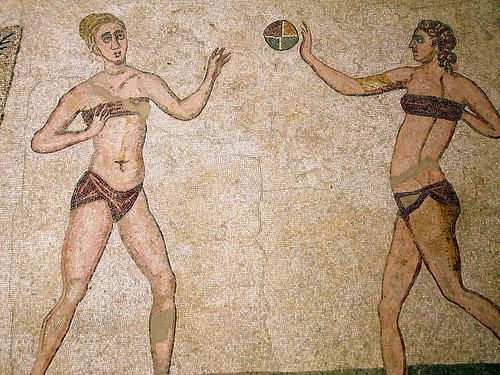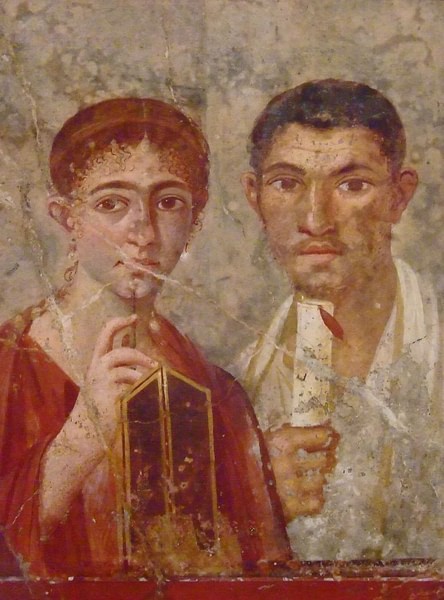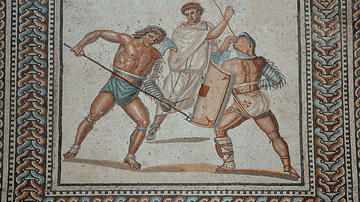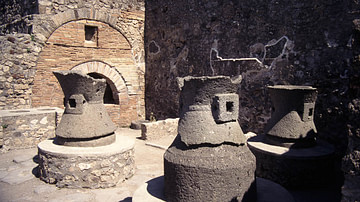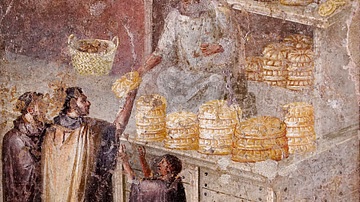From the early days of the Roman Republic through the volatile reigns of such ignoble emperors as Caligula, Nero, and Commodus, the Roman Empire continued to expand, stretching its borders to encompass the entire Mediterranean Sea as well as expanding northward to Gaul and Britain. History records the exploits of the heroes as well as the tirades of the emperors. Despite the sometimes shameful deeds of the imperial office, the empire was built on the backs of its citizens - the unsung people who lived a relatively quiet existence, and who are often ignored by history. Rome was a cosmopolitan city with Greeks, Syrians, Jews, North Africans, Spaniards, Gauls, and Britons, and like any society, the average Roman citizen awoke each morning, labored, relaxed, and ate, and while his or her daily life could often be hectic, he or she would always survive.
Population Movement
Outside the cities, in the towns and on the small farms, people lived a much simpler life - dependent almost entirely on their own labor. The daily life of the average city dweller, however, was a lot different and most often routine. The urban areas of the empire - whether it was Rome, Pompeii, Antioch, or Carthage - were magnets to many people who left smaller towns and farms seeking a better way of life. However, the unfulfilled promise of jobs forced countless people to live in the poorer parts of the city. The jobs they sought were often not there, resulting in an epidemic of homeless inhabitants. The work that was available to these new émigrés, however, was difficult to obtain. Slaves performed almost all of the menial jobs as well as many of the professions such as teachers, doctors, surgeons, and architects. Most of the freedmen worked at various trades, for example, as bakers, fishmongers, or carpenters. Occasionally, poor women would serve the affluent as hairdressers, midwives, or dressmakers.
Housing - Apartment Blocks
As elsewhere, whether on a farm or in the city, daily life still centered on the home, and when people arrived in the city, their first concern was to find a place to live. Space was at a premium in a walled metropolis like Rome, and from the beginning little attention was paid to the housing needs of the people who migrated to the city - tenements provided the best answer. The majority of Roman citizens, not all of them poor, lived in these apartment buildings or insulae. As early as 150 BCE, there were over 46,000 insulae throughout the city. Most of these ramshackle tenements were over-crowded and extremely dangerous resulting in residents living in constant fear of fire, collapse, and in some areas there was the susceptibility to the flooding of the Tiber River. Initially, little concern from the city was given to designing straight or even wide streets (streets, often unpaved, could be as narrow as six feet or as wide as fifteen), not allowing for easy access to these buildings if a fire did occur. It would take the great fire under Emperor Nero, to improve this problem when streets were widened and balconies built to provide safety as well as access in time of an emergency. These “flats” were usually five to seven stories in height (over seventy feet); however, because many of these tenements were deemed unsafe, laws were passed under Emperors Augustus and Trajan to keep them from becoming too tall; unfortunately, these laws were rarely enforced.
Poverty throughout the city was apparent, whether through one's lack of education or manner of dress, and life in these tenements reflected this disparity. The floor on which a person lived depended on one's income. The lower apartments - the ground floor or first floor of an insulae - were far more comfortable than the top floors. They were spacious, containing separate rooms for dining and sleeping, glazed windows, and, unlike the other floors, the rent was usually paid annually. The higher floors, where rent was paid by the day or week, were cramped, often with only one room to a family. A family lived in constant fear of eviction. They had no access to natural light, were hot in the summer and cold in the winter with little or no running water - this even meant a latrina or toilet. While the city's first sewer system or Cloaca Maxima had appeared in the six century BCE, it did not benefit those on the upper floors (lower floors had access to running water and indoor toilets). Refuse, even human waste, was routinely dumped onto the streets, not only causing a terrible stench but a breeding ground for disease. For many, the only alternative was to use the public toilets. Combine the lack of street lights (there was no foot traffic at night due to the high crime rate), the decaying buildings, and the fear of fire, life on the upper floors of the tenements was not very enjoyable for many of the poor.

Private Villas
On the contrary, most of the wealthy residents - those who didn't live in villas outside the city - lived in a domus. These homes, at least in Rome, were usually located on Palatine Hill to be close to the imperial palace. As with many of the tenements, the front of this dwelling (especially in cities like Pompeii and Herculaneum) often contained a shop where the owner would conduct daily business. Behind the shop was the atrium - a reception area where guests or clients were greeted and private business sometimes conducted. The atrium would often include a small shrine to a household or ancestral god. The ceiling of the atrium was open and beneath this was a rectangular pool. On rainy days the water that came through this opening was collected and used elsewhere in the domus. On either side of the atrium were smaller rooms, called cubiculum which served as bedrooms, libraries and offices. Of course, there was ample space available for a dining room or triclinium and the kitchen. To the rear of the domus was the family garden.
The Family
Regardless whether rich or poor, tenement or villa, the fundamental social unit throughout the empire was the family, and from the early days of the Republic, the existence of the family-centered entirely on the concept of paterfamilias - the male head of the household had the power of life and death over all members of the family (even the extended family). He could reject children if they were disfigured, if he questioned their paternity, if he had more than one daughter already or merely if he felt so inclined. He could also sell any of his children into slavery. Gradually, over time, this extreme, almost all-powerful, control over one's family (patria potestas) would diminish. However, this ironclad rule by the husband or father did not limit the power of the woman of the house.
The home was the domain of the wife. While she was initially restricted from appearing in public, she ran the household and often saw to the education of the children until a tutor could be found. By the end of the Republic, she was even permitted to sit with her husband at dinner, go to the baths, although not at the same time as the men, and attend the theater and games. Later, women could be seen working as bakers, pharmacists and shopkeepers and, legally, women's rights improved, for example, divorce proceedings could be initiated by either the husband or wife.
Food
Everyone has to eat, and the diet of a Roman resident depended, as did his or her housing, on one's economic status. For many of the poor this meant waiting for the monthly allotment of grain. To most Romans the main meal of the day was in the late afternoon, from four to six. The morning and noon meals were usually light snacks, sometimes only bread. Since there was no refrigeration, shopping was done daily at the many small shops and street carts or in the city's forum. Many of the foods we consider Italian today did not exist in early Rome. There were no potatoes, tomatoes, corn, peppers, rice, or sugar. Neither were there any oranges, grapefruits, apricots, or peaches. While the wealthy enjoyed imported spices in their meals, reclined on pillows and were served by slaves, many of the extremely poor or homeless ate rancid cereal or gruel (the lack of a quality diet caused many to suffer from malnutrition). To others the daily diet consisted of cereals, bread, vegetables and olive oil; meat was far too expensive for the average budget although it sometimes became available after a sacrifice to the gods (as only the internal organs were used in a sacrifice). Wine was the common drink, but, for the poor, water was available at the public fountains.
Work & Leisure
For the affluent the day was divided between business and leisure. Of course, business was only conducted in the morning. Most Romans worked a six-hour day, beginning at dawn and ending at noon, although, occasionally some shops might reopen in the early evening. The city's forum would be empty because the afternoon was devoted to leisure - attending the games (gladiatorial competitions, chariot races, or wrestling), the theater or the baths - all of which were also enjoyed by the poor (as many in government felt the need for the poor to be entertained). Even during times of crises, the citizens of Rome were kept happy with bread and games. They could be found at the Circus Maximus, Colosseum, or Theatre of Pompeii.
Throughout the empire, cities such as Antioch, Alexandria, Carthage or even Cathago Nova became romanized, containing an amphitheater or arena. The city of Pompeii had three municipal baths, two theaters, a basilica, and an amphitheater. During the time of Emperor Claudius there were 159 days when no business was conducted (no day of rest existed in a Roman week); however, Emperor Marcus Aurelius considered this too extreme and decreed there had to be at least 230 days of business.
Baths
After a busy day conducting business and attending the games, a Roman citizen needed to relax and this relaxation time was spent at the baths - bathing was important to all Romans (usually once or twice a week). The baths were a place to socialize and sometimes conduct business. In 33 BCE there were 170 in Rome, and by 400 CE there were over 800 including the largest and most sumptuous, the Baths of Trajan, Caracalla, and Diocletian. An emperor could always ensure his popularity by building baths. A typical bath included a gym, health center, swimming pool and sometimes even a bordello (for the more affluent guests). Most were very cheap to use and even free on public holidays. A typical bath would have three rooms - a tepidarium or relaxation room, a caldarium or hotter room, and a frigadarium or cooling room. Slaves were used to maintain the heat in the various hot rooms as well as attend to the needs of the wealthy. One of the most famous baths was the one given to the city by Emperor Diocletian. It covered thirty-two acres with a lavish garden, fountains, sculptures and even a running track. It could seat 3,000 guests. After a relaxing afternoon at the baths, a Roman citizen, wealthy or poor, would return home for their evening meal.
Conclusion
Daily life in a Roman city was completely dependent on one's economic status. The city, however, remained a mixture of wealth and poverty, often existing side by side. The wealthy had the benefit of slave labor whether it was heating the water at the baths, serving them their evening meal, or educating their children. The poor, on the other hand, had no access to education, lived in run-down tenements, and sometimes lived off the charity of the city. Historians still argue about the fall of the empire - was it religion or the influx of barbarians? However, there are those who point to the poor of the city - the squalor, the rise of the unemployed, and the increase in disease and crime - as a contributing factor to the western empire's eventual demise.
